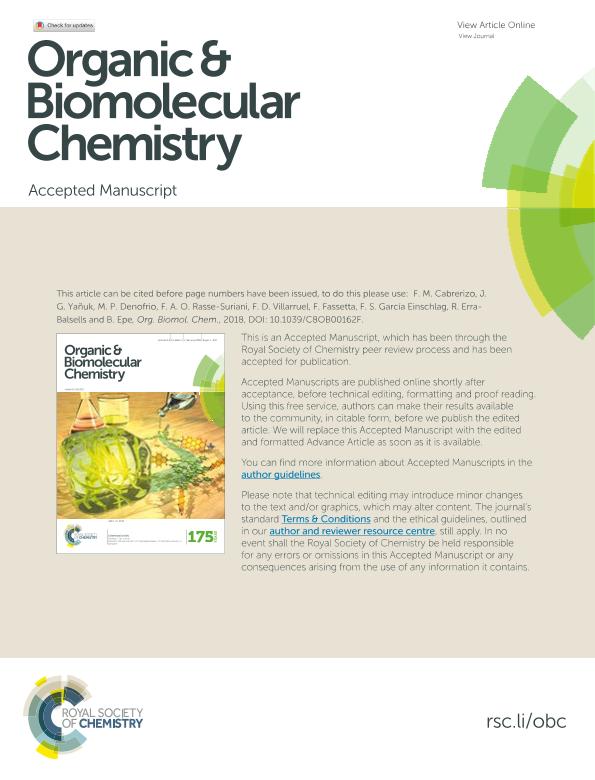Artículo
DNA damage photo-induced by chloroharmine isomers: hydrolysis versus oxidation of nucleobases
Yañuk, Juan Gabriel ; Denofrio, Maria Paula
; Denofrio, Maria Paula ; Rasse Suriani, Federico Ariel Osvaldo
; Rasse Suriani, Federico Ariel Osvaldo ; Villarruel Tapia, Fernando Diego; Fassetta, Federico; Garcia Einschlag, Fernando Sebastian
; Villarruel Tapia, Fernando Diego; Fassetta, Federico; Garcia Einschlag, Fernando Sebastian ; Erra Balsells, Rosa
; Erra Balsells, Rosa ; Epe, Bernd; Cabrerizo, Franco Martín
; Epe, Bernd; Cabrerizo, Franco Martín
 ; Denofrio, Maria Paula
; Denofrio, Maria Paula ; Rasse Suriani, Federico Ariel Osvaldo
; Rasse Suriani, Federico Ariel Osvaldo ; Villarruel Tapia, Fernando Diego; Fassetta, Federico; Garcia Einschlag, Fernando Sebastian
; Villarruel Tapia, Fernando Diego; Fassetta, Federico; Garcia Einschlag, Fernando Sebastian ; Erra Balsells, Rosa
; Erra Balsells, Rosa ; Epe, Bernd; Cabrerizo, Franco Martín
; Epe, Bernd; Cabrerizo, Franco Martín
Fecha de publicación:
02/2018
Editorial:
Royal Society of Chemistry
Revista:
Organic & Biomolecular Chemistry
ISSN:
1477-0520
Idioma:
Inglés
Tipo de recurso:
Artículo publicado
Clasificación temática:
Resumen
Photodynamic therapy (PDT) is an emerging clinical treatment currently being used against a wide range of both cancerous and noncancerous diseases. The search for new active photosensitizers as well as the development of novel selective delivery systems are the major challenges faced in the application of PDT. We investigated herein three chloroharmine derivatives (6-, 8- and 6,8-dichloroharmines) with quite promising intrinsic photochemical tunable properties and their ability to photoinduce DNA damage in order to elucidate the underlying photochemical mechanisms. Data revealed that the three compounds are quite efficient photosensitizers. The overall extent of photo-oxidative DNA damage induced by both 8-chloro-substituted β-carbolines is higher than that induced by 6-chloro-harmine. The predominant type of lesion generated also depends on the position of the chlorine atom in the β-carboline ring. Both 8-chloro-substituted β-carbolines mostly oxidize purines via type I mechanism, whereas 6-chloro-harmine mainly behaves as a ?clean? artificial photonuclease inducing single-strand breaks and site of base loss via proton transfer and concerted (HO−-mediated) hydrolytic attack. The latter finding represents an exception to the general photosensitizing reactions and, to the best of our knowledge, this is the first time that this process is well documented. The controlled and selective production of different oxygen-independent lesions could be fine-tuned by simply changing the substituent groups in the β-carboline ring. This could be a promising tool for the design and development of novel photo-therapeutic agents aimed to tackle hypoxic conditions shown in certain types of tumours.
Palabras clave:
DNA damage
,
β-Carbolines
Archivos asociados
Licencia
Identificadores
Colecciones
Articulos(CCT - LA PLATA)
Articulos de CTRO.CIENTIFICO TECNOL.CONICET - LA PLATA
Articulos de CTRO.CIENTIFICO TECNOL.CONICET - LA PLATA
Articulos(CIHIDECAR)
Articulos de CENTRO DE INVESTIGACIONES EN HIDRATOS DE CARBONO
Articulos de CENTRO DE INVESTIGACIONES EN HIDRATOS DE CARBONO
Articulos(IIB-INTECH)
Articulos de INST.DE INVEST.BIOTECNOLOGICAS - INSTITUTO TECNOLOGICO CHASCOMUS
Articulos de INST.DE INVEST.BIOTECNOLOGICAS - INSTITUTO TECNOLOGICO CHASCOMUS
Articulos(INIFTA)
Articulos de INST.DE INV.FISICOQUIMICAS TEORICAS Y APLIC.
Articulos de INST.DE INV.FISICOQUIMICAS TEORICAS Y APLIC.
Citación
Yañuk, Juan Gabriel; Denofrio, Maria Paula; Rasse Suriani, Federico Ariel Osvaldo; Villarruel Tapia, Fernando Diego; Fassetta, Federico; et al.; DNA damage photo-induced by chloroharmine isomers: hydrolysis versus oxidation of nucleobases; Royal Society of Chemistry; Organic & Biomolecular Chemistry; 16; 12; 2-2018; 2170-2184
Compartir
Altmétricas



